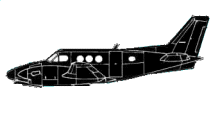
ASN Wikibase Occurrence # 42860
This information is added by users of ASN. Neither ASN nor the Flight Safety Foundation are responsible for the completeness or correctness of this information.
If you feel this information is incomplete or incorrect, you can submit corrected information.
| Date: | Saturday 22 May 1999 |
| Time: | 19:30 LT |
| Type: |  Beechcraft B90 King Air |
| Owner/operator: | Pac Int'l Skydiving Center |
| Registration: | N301DK |
| MSN: | LJ-372 |
| Year of manufacture: | 1968 |
| Engine model: | P&W PT6A-28 |
| Fatalities: | Fatalities: 1 / Occupants: 1 |
| Aircraft damage: | Destroyed |
| Category: | Accident |
| Location: | near Mokuleia, Oahu, HI -
 United States of America United States of America
|
| Phase: | Unknown |
| Nature: | Parachuting |
| Departure airport: | (KHDH) |
| Investigating agency: | NTSB |
| Confidence Rating: |
Following the 12th sport parachute jump of the day, which occurred after sunset, ground witnesses observed the airplane descend into the ocean in a left wing low, nose down attitude. They did not hear the engines sputtering or popping, or see the airplane make any erratic movements during its descent. Skydivers indicated that the two previous flights had been conducted at altitudes of at least 18,000 feet, and the accident flight and subsequent jump were made at 20,000 feet. During this final jump flight, one of the skydivers stated he had a hard time breathing and felt nauseous. The skydivers also noted that the pilot was unable to maintain a steady course and did not respond well to minor course corrections. No supplemental oxygen was found onboard the airplane during the recovery or subsequent inspection phases of the investigation. No skydiver observed the pilot using supplemental oxygen. The airplane manufacturer noted that the pressurization system would have been rendered inoperable due to a non-sealed cockpit door. Hypoxia is defined as a physiological condition where a person is bereft of needed oxygen. Judgment is poor and reaction time delayed. Total incapacitation coupled with a loss of consciousness can occur with little or no warning. The airframe, engines, and propellers were examined with no preexisting impact anomalies found.
Probable Cause: The pilot's incapacitation due to the effects of hypoxia from repeated flights to altitudes above 18,000 feet msl without supplemental oxygen.
Accident investigation:
 |
|
Sources:
NTSB LAX99LA190
Location
Revision history:
| Date/time | Contributor | Updates |
|---|---|---|
| 24-Oct-2008 10:30 | ASN archive | Added |
| 03-Feb-2013 14:11 | wf | Updated [Operator, Location, Nature, Source] |
| 21-Dec-2016 19:24 | ASN Update Bot | Updated [Time, Damage, Category, Investigating agency] |
| 26-Nov-2017 15:16 | ASN Update Bot | Updated [Operator, Departure airport, Source, Narrative] |
| 15-Jun-2023 03:54 | Ron Averes | Updated [[Operator, Departure airport, Source, Narrative]] |
| 08-Apr-2024 05:59 | ASN Update Bot | Updated [Time, Other fatalities, Departure airport, Source, Narrative, Category, Accident report] |
Corrections or additions? ... Edit this accident description
The Aviation Safety Network is an exclusive service provided by:


 ©2024 Flight Safety Foundation
©2024 Flight Safety Foundation